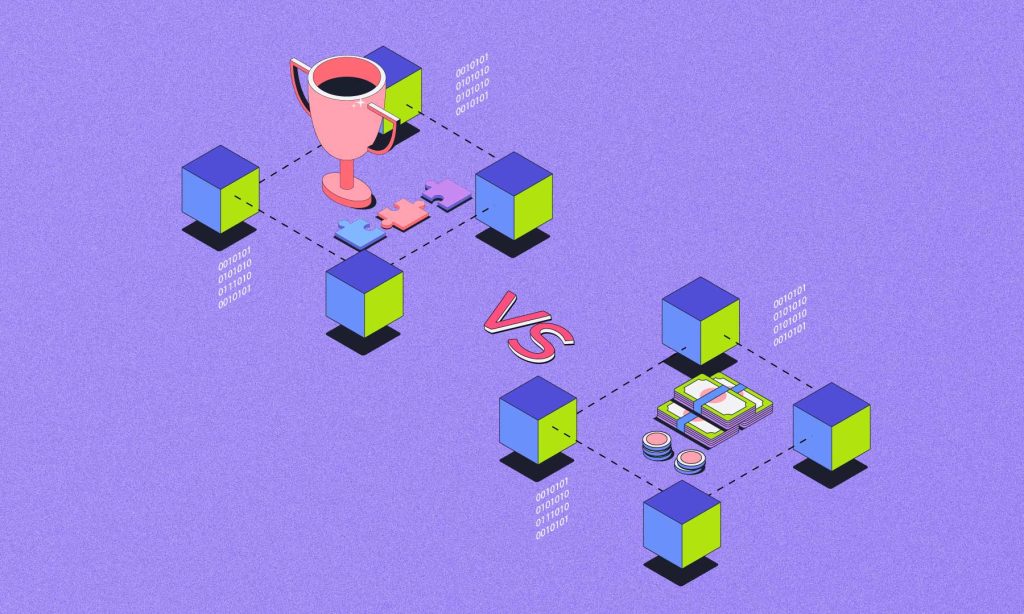The core idea of crypto is to create a way to verify transactions without a centralized authority. Cryptos, therefore, employ consensus mechanisms—a type of algorithm—to help with verification. Several cryptos, including Bitcoin, employ a mechanism called Proof of Work (PoW). This mechanism helps them achieve decentralization. That means they can verify transactions without a central authority. However, an increasing number of platforms—including Ethereum, Solana, Avalanche, and Cardano—now use proof of stake (PoS). However, there are challenges with both PoW and PoS. Here’s where we take stock of them.
What is Proof of Work (PoW)?
Bitcoin pioneered the use of PoW as a consensus mechanism. Mining is the process that PoW institutes to create new crypto and verify transactions.
PoW networks require a large processing capacity. Blockchains that use this mechanism rely on miners to contribute some of their computing power. They do this by competing to solve a mathematical puzzle of some kind. The power they contribute and the work miners do help keep the network secure.
But why would they agree to do it? The winner who wins and gets to update the blockchain with the most recent verified transactions receives a reward. The blockchain—which is basically a digital ledger the network maintains—is always kept up to date in this way. And since any participant on the network can check the ledger at any time, the chances of any data fudging going undetected are very low.
As a crypto’s worth rises, more miners are excited to join the network. This increases its power and security.
As effective as PoW is, due to its energy-intensive nature, developers have been looking to create alternative mechanisms. The most common and successful alternative to have emerged is PoS.
How does PoW work?
So, to sum up, and clarify the discussion above, PoW involves the following steps:
Step 1) Transactions are compiled and grouped into a block.
Step 2) Some network participants compete, and the winner gets to examine and validate the transactions in each block.
Step 3) The miner who validates the block and adds it to the chain of verified blocks first receives a reward.
Step 5) Transactions begin to collect until it is enough to constitute a block. A block is formed every 10 minutes.
The pros and cons of PoW
Now it’s time to take a moment to evaluate the pros and cons of the PoW mechanism. This is how it looks to us.
Pros
- Extremely secure due to its low operating costs. As a result, the network is more open and autonomous.
- Only consensus method that has been successful at Bitcoin’s scale.
Cons
- Requires large and increasing amounts of energy.
- Produces a significant quantity of e-waste.
- Slower and less adaptable than PoS.
What is Proof of Stake (PoS)?
Proof of Stake (PoS) is another consensus mechanism. That means it determines which participants get to verify transactions on the network and receive rewards.
Participants earn the right to verify transactions by staking their crypto. Some PoS cryptos give those with higher stakes a better chance of adding a block. Staking involves depositing crypto on the blockchain via a smart contract.
The assumption is that since stakes have more skin in the game, it is less likely that they will validate fraudulent data. Besides, they may be penalized and lose some or all of their stake.
How does PoS work?
One could say that the PoS consensus mechanism works as follows:
Step 1) Users who own native tokens of a blockchain securely lock up all or a portion of them via smart contracts.
Step 2) The algorithm selects the next validator from all the stakes at random.
Step 3) The selected individual must verify the transactions and add the block.
Step 4) The database is updated with a new block.
Step 5) The validator then receives a transaction reward.
Pros and cons of PoS
Now, let’s take a moment to look at the pros and cons of PoS.
Pros
- Faster transfers and greater scalability.
- Lower environmental effect.
- Offers incentives for block validation.
Cons
- Thoroughly tested and demonstrated at scale.
- Prone to consolidation.
- May not be as tamper-resistant or secure as PoW.
When should PoW and PoS be used?
The needs of the network determine the type of consensus mechanism. While it is not for us to say how a project should choose PoW and PoS, here are some factors developers consider.
PoW, for example, works well for fraud prevention, security, and trust-building. Because miners (or independent data processors) cannot be misled about a transaction.
It also increases the difficulty of mining over time while securing the transaction history of a crypto asset. This ensures that PoW cryptos control the coins in circulation easily, protecting the price against inflation.
Finally, PoW also maintains a distributed clock. This enables miners to freely join and exit the network while maintaining consistent operations.
A PoS-based mechanism, on the other hand, has major implications for network performance and security. When high on-chain transaction speeds are needed, PoS is preferred. Also, since validators are likely to own substantial amounts of the network token, it incentivizes them to keep the chain secure.
Besides, over time, due to mining pools, ordinary participants now stand little chance of receiving mining rewards. However, this is not the case with PoS, where everyone still has an equal chance.
We hope this article has given you some food for thought and helped you understand PoW and PoS better. If you want to read another article on the same topic, go here.
FAQs
What are the advantages and disadvantages of using PoS over PoW?
Advantages:
Energy Efficiency: PoS consumes significantly less energy compared to PoW, making it more environmentally friendly.
Faster Transaction Verification: PoS processes transactions faster than PoW, providing quicker validation of network activities.
Cost Efficiency: PoS is often more cost-effective as it doesn’t require expensive mining hardware.
Disadvantages:
Security Concerns: PoS is considered less secure than PoW because it doesn’t offer the same level of decentralization and equal participation among nodes.
Risk of Centralization: There is a risk of centralization as wealthier participants have more influence, potentially concentrating power in a few hands.
Dependency on Wealth: PoS relies on participants’ stake in the system, which may lead to a power concentration based on financial resources.
What are the problems with proof-of-work?
Energy Consumption: PoW mining requires substantial computational power, leading to high energy consumption and environmental concerns. The process demands significant electricity, particularly in locations with cheap power, contributing to carbon emissions.
Centralization Risk: PoW systems may consolidate into a few powerful mining entities, raising concerns about centralization and potential manipulation.
Security Challenges: While PoW makes double-spending difficult, it may not be as tamper-resistant or secure as other consensus mechanisms.
Mining Pools: Mining pools can concentrate power among a few participants, impacting the decentralization ethos of blockchain.
Scalability: The proof-of-work model may face scalability challenges as the network grows, leading to potential delays and higher transaction costs.
What are the main disadvantages of proof of stake?
PoS faces criticism for security vulnerabilities, complexity, potential centralization, and the influence of large validators.
What is the limitation of using the consensus algorithm PoW?
High Energy Consumption: PoW requires significant computing power, leading to substantial energy consumption, making it environmentally unsustainable.
E-Waste Production: The process generates a notable amount of electronic waste, contributing to environmental concerns and sustainability issues.
Slower Transaction Speed: PoW can result in slower transaction processing times compared to alternative consensus mechanisms, affecting the overall efficiency of the blockchain network.
Vulnerability to 51% Attacks: There is a risk of a 51% attack where a malicious entity gains control of the majority of the network’s mining power, potentially compromising the integrity of the blockchain.
Less Adaptable: PoW is slower to adapt to changes in network conditions compared to some alternative consensus algorithms like Proof-of-Stake (PoS).








